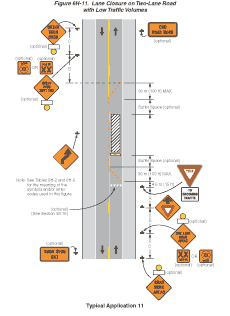Chapter 6H. Typical Applications
Section 6H.01 Typical Applications
Support:
Whenever the acronym "TTC" is used in this Chapter, it
refers to "temporary traffic control".
Standard:
The needs and control of all road users (motorists, bicyclists,
and pedestrians within the highway, including persons with disabilities
in accordance with the Americans with Disabilities Act of 1990 (ADA),
Title II, Paragraph 35.130) through a TTC zone shall be an essential
part of highway construction, utility work, maintenance operations,
and the management of traffic incidents.
Support:
Chapter 6G contains discussions of typical
TTC activities. Chapter 6H presents typical applications for a variety
of situations commonly encountered. While not every situation is
addressed, the information illustrated can generally be adapted
to a broad range of conditions. In many instances, an appropriate
TTC plan is achieved by combining features from various typical
applications. For example, work at an intersection might present
a near-side work zone for one street and a far-side work zone for
the other street. These treatments are found in two different typical
applications, while a third typical application shows how to handle
pedestrian crosswalk closures. For convenience in using the typical
application diagrams, Tables 6C-1
and 6C-4 are
reproduced in this Chapter as Tables 6H-3
and 6H-4, respectively.
Procedures for establishing TTC zones vary with such conditions as road configuration, location of the work, work activity, duration of work, road user volumes, road vehicle mix (buses, trucks, cars, motorcycles, and bicycles), and road user speeds. Examples are presented in this Chapter showing how to apply principles and standards. Applying these guidelines to actual situations and adjusting to field conditions requires judgment. In general, the procedures illustrated represent minimum solutions for the situations depicted.
Option:
Other devices may be added to supplement the devices and device
spacing may be adjusted to provide additional reaction time or delineation.
Fewer devices may be used based on field conditions.
Support:
Figures and tables found throughout Part
6 provide information for the development of TTC plans. Also,
Table 6H-3 is used for the determination of sign spacing and other
dimensions for various area and roadway types.
Table 6H-1 is an index of the 46 typical applications. Typical applications are shown on the right page with notes on the facing page to the left. The legend for the symbols used in the typical applications is provided in Table 6H-2. In many of the typical applications, sign spacings and other dimensions are indicated by letters using the criteria provided in Table 6H-3. The formulas for determining taper lengths are provided in Table 6H-4.
Most of the typical applications show TTC devices for only one direction.
| Typical Application Description | Typical Application Number |
|---|---|
| Work Outside of Shoulder (see Section 6G.06) | |
| Work Beyond the Shoulder | TA-1 |
| Blasting Zone | TA-2 |
| Work on the Shoulder (see Sections 6G.07 and 6G.08) | |
| Work on Shoulders | TA-3 |
| Short Duration or Mobile Operation on Shoulder | TA-4 |
| Shoulder Closure on Freeway | TA-5 |
| Shoulder Work with Minor Encroachment | TA-6 |
| Work Within the Traveled Way of Two-Lane Highways (see Section 6G.10) | |
| Road Closed with Diversion | TA-7 |
| Roads Closed with Off-Site Detour | TA-8 |
| Overlapping Routes with Detour | TA-9 |
| Lane Closure on Two-Lane Road Using Flaggers | TA-10 |
| Lane Closure on Two-Lane Road with Low Traffic Volumes | TA-11 |
| Lane Closure on Two-Lane Road Using Traffic Control Signals | TA-12 |
| Temporary Road Closure | TA-13 |
| Haul Road Crossing | TA-14 |
| Work in Center of Road with Low Traffic Volumes | TA-15 |
| Surveying Along Centerline of Road with Low Traffic Volumes | TA-16 |
| Mobile Operations on Two-Lane Road | TA-17 |
| Work Within the Traveled Way of Urban Streets (see Section 6G.11) | |
| Lane Closure on Minor Street | TA-18 |
| Detour for One Travel Direction | TA-19 |
| Detour for Closed Street | TA-20 |
| Work Within the Traveled Way at an Intersection and Sidewalks (see Section 6G.13) | |
| Lane Closure on Near Side of Intersection | TA-21 |
| Right Lane Closure on Far Side of Intersection | TA-22 |
| Left Lane Closure on Far Side of Intersection | TA-23 |
| Half Road Closure on Far Side of Intersection | TA-24 |
| Multiple Lane Closures at Intersection | TA-25 |
| Closure in Center of Intersection | TA-26 |
| Closure at Side of Intersection | TA-27 |
| Sidewalk Closures and Bypass Sidewalks | TA-28 |
| Crosswalk Closures and Pedestrian Detours | TA-29 |
| Work Within the Traveled Way of Multi-lane, Nonaccess Controlled Highways (see Section 6G.12) | |
| Interior Lane Closure on Multi-lane Street | TA-30 |
| Lane Closure on Street with Uneven Directional Volumes | TA-31 |
| Half Road Closure on Multi-lane, High-Speed Highway | TA-32 |
| Lane Closure on Divided Highway | TA-33 |
| Lane Closure with Temporary Traffic Barrier | TA-34 |
| Mobile Operation on Multi-lane Road | TA-35 |
| Work Within the Traveled Way of Expressways and Freeways (see Section 6G.14) | |
| Lane Shift on Freeway | TA-36 |
| Double Lane Closure on Freeway | TA-37 |
| Interior Lane Closure on Freeway | TA-38 |
| Median Crossover on Freeway | TA-39 |
| Median Crossover for Entrance Ramp | TA-40 |
| Median Crossover for Exit Ramp | TA-41 |
| Work in Vicinity of Exit Ramp | TA-42 |
| Partial Exit Ramp Closure | TA-43 |
| Work in Vicinity of Entrance Ramp | TA-44 |
| Temporary Reversible Lane Using Movable Barriers | TA-45 |
| Work in the Vicinity of Highway-Rail Grade Crossings (see Section 6G.19) | |
| Work in Vicinity of Highway-Rail Grade Crossing | TA-46 |
| Road Type | Distance Between Signs** | ||
|---|---|---|---|
| A | B | C | |
| Urban (low speed)* | 30 (100) | 30 (100) | 30 (100) |
| Urban (high speed)* | 100 (350) | 100 (350) | 100 (350) |
| Rural | 150 (500) | 150 (500) | 150 (500) |
| Expressway / Freeway | 300 (1,000) | 450 (1,500) | 800 (2,640) |
** Distances are shown in meters (feet). The column headings A, B, and C are the dimensions shown in Figures 6H-1 through 6H-46. The A dimension is the distance from the transition or point of restriction to the first sign. The B dimension is the distance between the first and second signs. The C dimension is the distance between the second and third signs. (The third sign is the first one in a three-sign series encountered by a driver approaching a TTC zone.)
| Speed Limit (S) |
Taper Length (L) |
Speed Limit (S) | Taper
Length (L) Feet |
|---|---|---|---|
| 60 km/h or less | 40 mph or less | ||
| 70 km/h or more | 45 mph or more |
Where:
L = taper length in meters (feet)
W = width of offset in meters (feet)
S = posted speed limit, or off-peak 85th-percentile
speed prior to work starting, or the anticipated operating speed
in km/h (mph).
Notes for Figure 6H-1—Typical Application 1
Work Beyond the Shoulder
Guidance:
- If the work space is in the median of a divided highway, an advance warning sign should also be placed on the left side of the directional roadway.
Option:
- The ROAD WORK AHEAD sign may be replaced with other appropriate signs such as the SHOULDER WORK sign. The SHOULDER WORK sign may be used for work adjacent to the shoulder.
- The ROAD WORK AHEAD sign may be omitted where the work space is behind a barrier, more than 600 mm (24 in) behind the curb, or 4.6 m (15 ft) or more from the edge of any roadway.
- For short-term, short-duration or mobile operation, all signs and channelizing devices may be eliminated if a vehicle with activated rotating lights or strobe lights is used.
- Vehicle hazard warning signals may be used to supplement rotating lights or strobe lights.
Standard:
- Vehicle hazard warning signals shall not be used instead of the vehicle’s rotating lights or strobe lights.
Figure 6H-1 Work Beyond the Shoulder (TA-1)
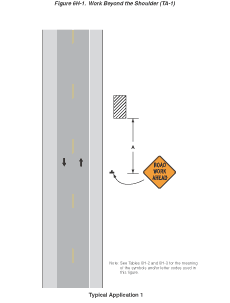
Notes for Figure 6H-2—Typical Application 2
Blasting Zone
Standard:
- Whenever blasting caps are used within 300 m (1,000 ft) of a roadway, the signing shown shall be used.
- The signs shall be covered or removed when there are no explosives in the area or the area is otherwise secure.
- Whenever a side road intersects the roadway between the BLASTING ZONE AHEAD sign and the END BLASTING ZONE sign, or a side road is within 300 m (1,000 ft) of any blasting cap, similar signing, as on the mainline, shall be installed on the side road.
- Prior to blasting, the blaster in charge shall determine whether road users in the blasting zone will be endangered by the blasting operation. If there is danger, road users shall not be permitted to pass through the blasting zone during blasting operations.
Guidance:
- On a divided highway, the signs should be mounted on both sides of the directional roadways.
Figure 6H-2 Blasting Zone (TA-2)
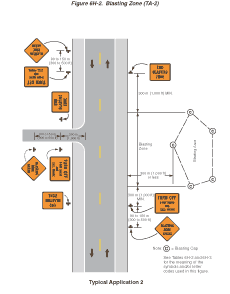
Notes for Figure 6H-3—Typical Application 3
Work on Shoulders
Guidance:
- A SHOULDER WORK sign should be placed on the left side of the roadway for a divided or one-way street only if the left shoulder is affected.
Option:
- The Workers symbol signs may be used instead of SHOULDER WORK signs.
- The SHOULDER WORK AHEAD sign on an intersecting roadway may be omitted where drivers emerging from that roadway will encounter another advance warning sign prior to this activity area.
- For short-duration operations of 60 minutes or less, all signs and channelizing devices may be eliminated if a vehicle with activated rotating lights or strobe lights is used.
- Vehicle hazard warning signals may be used to supplement rotating lights or strobe lights.
Standard:
- Vehicle hazard warning signals shall not be used instead of the vehicle’s high-intensity rotating, flashing, oscillating, or strobe lights.
- When paved shoulders having a width of 2.4 m (8 ft) or more are closed, at least one advance warning sign shall be used. In addition, channelizing devices shall be used to close the shoulder in advance to delineate the beginning of the work space and direct vehicular traffic to remain within the traveled way.
Figure 6H-3 Work on Shoulders (TA-3)

Notes for Figure 6H-4—Typical Application 4
Short-Duration or Mobile Operation on Shoulder
Guidance:
- In those situations where multiple work locations within a limited distance make it practical to place stationary signs, the distance between the advance warning sign and the work should not exceed 8 km (5 mi).
- In those situations where the distance between the advance signs and the work is 3.2 km (2 mi) to 8 km (5 mi), a Supplemental Distance plaque should be used with the ROAD WORK AHEAD sign.
Option:
- The ROAD WORK NEXT XX km (MILES) sign may be used instead of the ROAD WORK AHEAD sign if the work locations occur over a distance of more than 3.2 km (2 mi).
- Warning signs may be omitted when the work vehicle displays rotating lights or strobe lights if the distance between work locations is 1.6 km (1 mile) or more, and if the work vehicle travels at vehicular traffic speeds between locations.
- Vehicle hazard warning signals may be used to supplement rotating lights or strobe lights.
Standard:
- Vehicle hazard warning signals shall not be used instead of the vehicle’s high-intensity rotating, flashing, oscillating, or strobe lights.
- If an arrow panel is used for an operation on the shoulder, the caution mode shall be used.
Figure 6H-4 Short-Duration or Mobile Operation on Shoulder (TA-4)
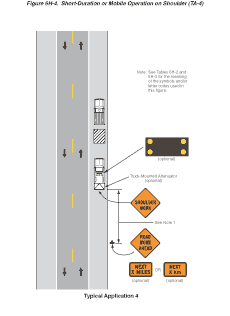
Notes for Figure 6H-5—Typical Application 5
Shoulder Closure on Freeway
Guidance:
- SHOULDER CLOSED signs should be used on limited-access highways where there is no opportunity for disabled vehicles to pull off the roadway.
- If drivers cannot see a pull-off area beyond the closed shoulder, information regarding the length of the shoulder closure should be provided in meters or kilometers (feet or miles), as appropriate.
- The use of a temporary traffic barrier should be based on engineering judgment.
Standard:
- Where temporary traffic barriers are installed, the ends of the barrier shall be treated in accordance with the provisions of Section 6F.81.
Option:
- The barrier shown in this typical application is an example of one method that may be used to close a shoulder of a long-term project.
- The warning lights shown on the barrier may be used.
Figure 6H-5 Shoulder Closure on Freeway (TA-5)
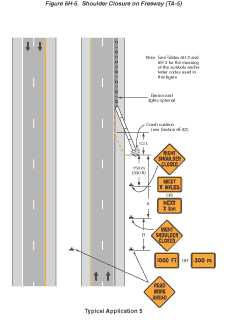
Notes for Figure 6H-6—Typical Application 6
Shoulder Work with Minor Encroachment
Guidance:
- All lanes should be a minimum of 3 m (10 ft) in width as measured to the near face of the channelizing devices.
- The treatment shown should be used on a minor road having low speeds. For higher-speed traffic conditions, a lane closure should be used.
Option:
- For short-term use on low-volume, low-speed roadways with vehicular traffic that does not include longer and wider heavy commercial vehicles, a minimum lane width of 2.7 m (9 ft) may be used.
- Where the opposite shoulder is suitable for carrying vehicular traffic and of adequate width, lanes may be shifted by use of closely spaced channelizing devices, provided that the minimum lane width of 3 m (10 ft) is maintained.
- Additional advance warning may be appropriate, such as a ROAD NARROWS sign.
- Temporary traffic barriers may be used along the work space.
- The shadow vehicle may be omitted if a taper and channelizing devices are used.
- A truck-mounted attenuator may be used on the shadow vehicle.
- For short-duration work, the taper and channelizing devices may be omitted if a shadow vehicle with activated high-intensity rotating, flashing, oscillating, or strobe lights is used.
- Vehicle hazard warning signals may be used to supplement high-intensity rotating, flashing, oscillating, or strobe lights.
Standard:
- Vehicle hazard warning signals shall not be used instead of the vehicle’s high-intensity rotating, flashing, oscillating, or strobe lights.
Figure 6H-6 Shoulder Work with Minor Encroachment (TA-6)
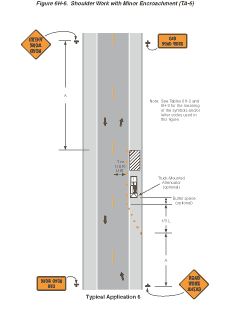
Notes for Figure 6H-7—Typical Application 7
Road Closure with Diversion
Support:
- Signs and object markers are shown for one direction of travel only.
Standard:
- Devices similar to those depicted shall be placed for the opposite direction of travel.
- Pavement markings no longer applicable shall be removed or obliterated as soon as practicable.
- Temporary barriers and end treatments shall be crashworthy.
Guidance:
- If the tangent distance along the temporary diversion is more than 180 m (600 ft), a Reverse Curve sign, left first, should be used instead of the Double Reverse Curve sign, and a second Reverse Curve sign, right first, should be placed in advance of the second reverse curve back to the original alignment.
- When the tangent section of the diversion is more than 180 m (600 ft), and the diversion has sharp curves with recommended speeds of 50 km/h (30 mph) or less, Reverse Turn signs should be used.
- Where the temporary pavement and old pavement are different colors, the temporary pavement should start on the tangent of the existing pavement and end on the tangent of the existing pavement.
Option:
- Flashing warning lights and/or flags may be used to call attention to the warning signs.
- On sharp curves, large arrow signs may be used in addition to other advance warning signs.
- Delineators or channelizing devices may be used along the diversion.
Figure 6H-7 Road Closure with Diversion (TA-7)
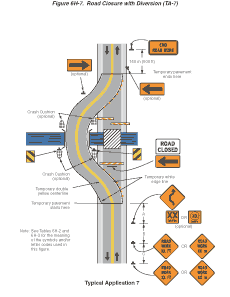
Notes for Figure 6H-8—Typical Application 8
Road Closure with Off-Site Detour
Guidance:
- Regulatory traffic control devices should be modified as needed for the duration of the detour.
Option:
- If the road is opened for some distance beyond the intersection and/or there are significant origin/destination points beyond the intersection, the ROAD CLOSED and DETOUR signs on Type III Barricades may be located at the edge of the traveled way.
- A Route Sign Directional assembly may be placed on the far left corner of the intersection to augment or replace the one shown on the near right corner.
- Flashing warning lights and/or flags may be used to call attention to the advance warning signs.
- Cardinal direction plaques may be used with route signs.
Figure 6H-8 Road Closure with Off-Site Detour (TA-8)
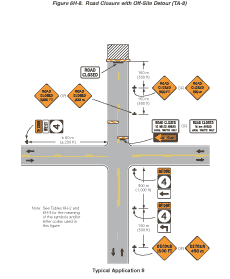
Notes for Figure 6H-9—Typical Application 9
Overlapping Routes with Detour
Support:
- TTC devices are shown for one direction of travel only.
Standard:
- Devices similar to those depicted shall be placed for the opposite direction of travel.
Guidance:
- STOP signs displayed to side roads should be installed as needed along the temporary route.
Option:
- Flashing warning lights and/or flags may be used to call attention to the advance warning signs.
- Flashing warning lights may be used on the Type III Barricades.
- Cardinal direction plaques may be used with route signs.
Figure 6H-9 Overlapping Routes with Detour (TA-9)
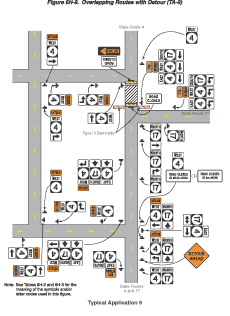
Notes for Figure 6H-10—Typical Application 10
Lane Closure on Two-Lane Road Using Flaggers
Option:
- For low-volume situations with short work zones on straight roadways where the flagger is visible to road users approaching from both directions, a single flagger, positioned to be visible to road users approaching from both directions, may be used (see Chapter 6E).
- The ROAD WORK AHEAD and the END ROAD WORK signs may be omitted for short-duration operations.
- Flashing warning lights and/or flags may be used to call attention to the advance warning signs. A BE PREPARED TO STOP sign may be added to the sign series.
Guidance:
- The buffer space should be extended so that the two-way traffic taper is placed before a horizontal (or crest vertical) curve to provide adequate sight distance for the flagger and a queue of stopped vehicles.
Standard:
- At night, flagger stations shall be illuminated, except in emergencies.
Guidance:
- When used, the BE PREPARED TO STOP sign should be located between the Flagger sign and the ONE LANE ROAD sign.
- When a highway-rail grade crossing exists within or upstream of the transition area and it is anticipated that queues resulting from the lane closure might extend through the highway-rail grade crossing, the TTC zone should be extended so that the transition area precedes the highway-rail grade crossing.
- When a highway-rail grade crossing equipped with active warning devices exists within the activity area, provisions should be made for keeping flaggers informed as to the activation status of these warning devices.
- When a highway-rail grade crossing exists within the activity area, drivers operating on the left side of the normal centerline should be provided with comparable warning devices as for drivers operating on the right side of the normal centerline.
- Early coordination with the railroad company should occur before work starts.
Option:
- A flagger or a uniformed law enforcement officer may be used at the highway-rail grade crossing to minimize the probability that vehicles are stopped within 4.6 m (15 ft) of the highway-rail grade crossing, measured from both sides of the outside rails.
Figure 6H-10 Lane Closure on Two-Lane Road Using Flaggers (TA-10)
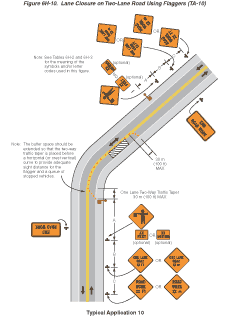
Notes for Figure 6H-11—Typical Application 11
Lane Closure on Two-Lane Road with Low Traffic Volumes
Option:
- This TTC zone application may be used as an alternate to the
TTC application shown in Figure 6H-10 (using flaggers) when the
following conditions exist:
- Vehicular traffic volume is such that sufficient gaps exist for vehicular traffic that must yield.
- Road users from both directions are able to see approaching vehicular traffic through and beyond the work site and have sufficient visibility of approaching vehicles.
- The Type B flashing warning lights may be placed on the ROAD WORK AHEAD and the ONE LANE ROAD AHEAD signs whenever a night lane closure is necessary.
Figure 6H-11 Lane Closure on Two-Lane Road with Low Traffic Volumes (TA-11)
